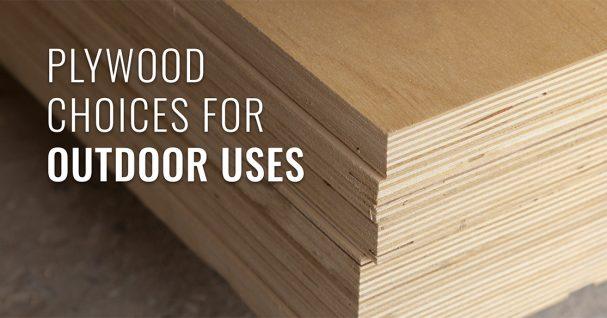
- How to Fix a Leak Behind the Handle of an Outdoor Faucet
- Caring For a Fiddle Leaf Fig Outdoors
- What Is The Best Patio Grout Option For Your New Patio?
- How Food Workers Should Prevent Pests from Outdoor Dumpsters? : A Guide for Food Workers
- What are the parts of an outdoor and indoor air conditioning unit?
Plywood is the building material of choice for many projects, mostly because of its strength, versatility, and affordability. However, not every plywood is made the same. It’s important to choose the right plywood for your project, especially if you’re building outdoors and need it to withstand the elements. There are different types of exterior plywood to work with on an outdoor project, such as a deck, shelving, or even a boat! The construction grade of the plywood is important, but so is the look and feel of it, depending on how you plan to use it.
How is Plywood Used Outdoors?
Exterior plywood is weather (and water) resistant, so it’s strong enough to be used outside and also in areas that are exposed to water and humidity, like a garage. This type of plywood, often made from Douglas fir, is made stronger by adhering its layers with a waterproof glue.
Read more : Indoor Hydrangea FAQ
Exterior plywood can be used on decks and walkways (think: a sturdy path down to a beach), a shed, outdoor shelving, and for outdoor structures and furniture, like a gazebo, bench, or planters. Typically, it’s not a very pretty wood, as it has visible knots or other blemishes, but there are some types whose appearance is much cleaner and, therefore, better for projects where aesthetics are important.
What Types of Exterior Plywood Can Be Used Outdoors?
There are many types of exterior plywood to choose from — the most common being CDX or ACX. Exterior plywood is marked with an X to denote this use and the construction grade is in the first two letters; the first letter refers to the front of the plywood and the second refers to the back. A is a premium grade that can be used on cabinetry or other higher-end uses where appearance is crucial. CDX is a more affordable, construction grade option that is still sturdy and will not crumble after a rainstorm. The layers can be made from veneers, high-density hardwood, or light hardwood.
While similar to standard exterior plywoods, marine plywood is the highest quality (AA, AB, and BB), constructed from wood without knots. Eliminating the knots in wood improves durability because it practically eliminates the possibility of water pockets forming within the wood. As its name suggests, marine plywood is used to build boats or other marine applications because it’s less prone to cracking while being shaped. If you picture the curve of a boat — and then imagine if that were to crack, you wouldn’t be in great shape. It’s also easier to cut and sand, leaving cleaner edges. This type of plywood can also be used in aircraft construction, as well as for your outdoor furniture and structures.
Read more : Top 5 Best Fly Repellents (2023 Review)
Other types of exterior plywood include: pressure treated plywood, overlaid plywood, oriented strand board (OSB), and T1-11. Pressure treated plywood is regular plywood infused with chemicals that add to its resistance against mold and mildew. Overlaid is similar to ACX or CDX but with a cleaner finish that not only makes it more attractive but holds up better against wear and tear. OSB is an engineered substitute that’s best suited for areas that are only semi-exposed to the elements. T1-11 is most commonly used for siding.
What are the Differences Between Exterior Plywoods?
Construction and cost are the biggest differences between types of exterior plywood. Marine plywood is often the most expensive and that is because of both its look and construction. CDX is the least expensive choice, but that doesn’t mean it won’t hold up well outside, just that it is better suited as the inner-core for a project that you’ll maybe cover in siding, rather than a focal point of a piece of furniture or a pergola, for instance. A good middle ground is ACX: less expensive than marine plywood but more attractive than CDX.
Beside cost and look, each type of exterior plywood has a different thickness and weight, which will also affect the weight of the plywood and, therefore, the best ways to use it. Marine plywood is the heaviest, which is great for durability of a bench in your yard or on a boardwalk, but if used as shelving or siding, it may buckle under the weight.
Fortunately, there are a variety of exterior plywoods to choose from for your outdoor building needs and picking the right one shouldn’t feel limiting at all. It’s best to consult with a professional so they can assess both your budget and needs in order to help you select the best plywood for your project.
Source: https://gardencourte.com
Categories: Outdoor

